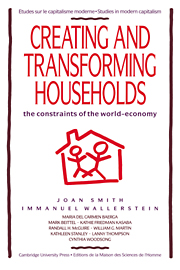2 - Lesotho: the creation of the households
Published online by Cambridge University Press: 07 June 2010
Summary
Southern Africa's great cities are colonial creations, born of the overseas expansion of the European world-economy. As such they drew upon local and global resources, of which none was more important than continuing inflows of labor to provide the sinews of mineral and then industrial production. The process of labor force formation was considerably complicated by the circulating character of the African migrant flow. Dictated at first by the structure of mining production and African communities, and later by the imposition of state control, many Black households have sustained substantive ties to their rural area of origin. The households of urban Black workers for much of the past century were households split over geographic space. Even within a continent marked by labor migration, these movements have been so large and enduring that southern Africa has long been called “Africa of the labor reserves.”
These urban–rural movements have been central to production and of great concern to state authorities. Numerous studies by state commissions, by private enterprises involved in hiring migrant workers, and by academic researchers have described the contours of migration for almost as long as it has taken place. We know, for example, much about the direction and volume of total migrant flows, especially to the gold mines of South Africa. Great attention has also been paid to the private and public institutions that have controlled migration. Yet when one turns to the rural areas, the literature is curiously underdeveloped.
- Type
- Chapter
- Information
- Creating and Transforming HouseholdsThe Constraints of the World-Economy, pp. 231 - 250Publisher: Cambridge University PressPrint publication year: 1992
- 2
- Cited by



